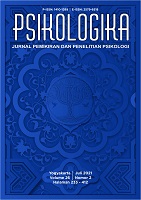Main Article Content
Abstract
During the economic crisis occurring in Indonesian, entrepreneurial sector has been the solution for Indonesian economic downturn. Until the current time, entrepreneurship keeps becoming the cornerstone for the government in improving Indonesia economic growth. However, entrepreneur women face more specific obstacles which complicate their steps, then it causes the fact that there are more entrepreneur women have contributions in Indonesian economic growth (60%) is less exposed (Tjahjadi et al., 2019). The study is aimed to identify the relationship between adversity quotients with entrepreneurial intentions of entrepreneur women. The hypothesis proposed in this study is that there is a positive relationship between adversity quotients with entrepreneurial intentions of entrepreneur women. The research subjects were 100 batik entrepreneur women. The scale used in this study was made based on the aspects of the Theory Planned Behavior (TPB) by Ajzen for the entrepreneurial intention variable and aspects of the Adversity Response Profile (ARP) by Stotlz for the adversity quotient variable. The hypothesis test result using Pearson's product-moment showed a correlation number r of .497 and p = .000 (p < .01). It indicates that there is a significant relationship between Adversity Quotient and Entrepreneurial Intensity so that the proposed hypothesis is accepted. The implication of the research is for encouraging the entrepreneur women to create solution to overcome adversities in developing the business.
Article Details
Authors who publish with this journal agree to the following terms:
- Authors retain copyright and grant the journal right of first publication with the work simultaneously licensed under a Creative Commons Attribution-ShareAlike 4.0 International License that allows others to share the work with an acknowledgment of the work's authorship and initial publication in this journal.
- Authors are able to enter into separate, additional contractual arrangements for the non-exclusive distribution of the journal's published version of the work (e.g., post it to an institutional repository or publish it in a book), with an acknowledgment of its initial publication in this journal.
- Authors are permitted and encouraged to post their work online (e.g., in institutional repositories or on their website) prior to and during the submission process, as it can lead to productive exchanges, as well as earlier and greater citation of published work (See The Effect of Open Access).




